




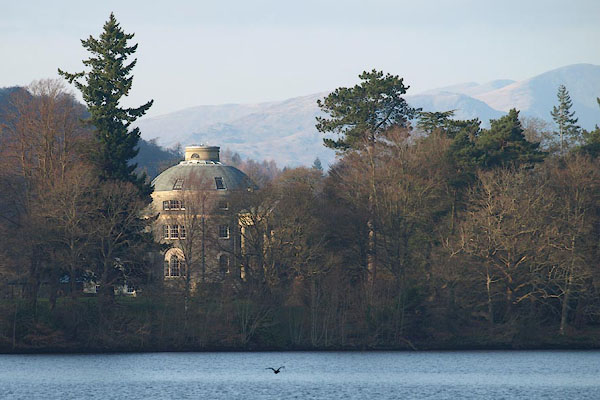
BOR64.jpg (taken 15.2.2008)
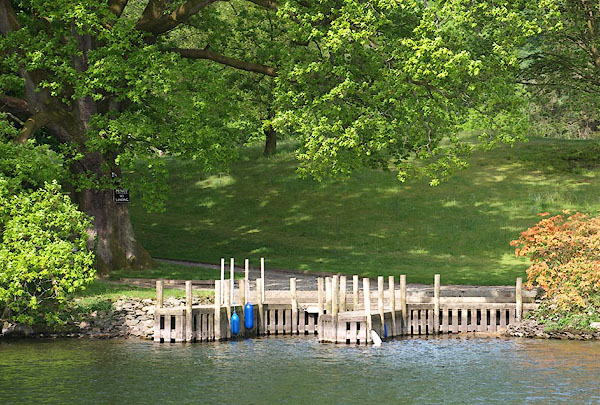
BPD49.jpg Jetty.
(taken 12.5.2008)
placename:- Belle Isle
OS County Series (Wmd 32 11)
"... it [Windermere] has many little hills or isles in it, one of a great bigness is 30 acres of ground on which is a house, the Gentleman that is Lord of the Manour lives in it Sir Christopher Phillips; he has a great command of the water, and of the villages thereabout and many privileges, he makes a Major or Bailiff of the place during life; its but a small mean place, ... the Isle did not looke to be so bigg at the shore but takeing boate I went on it and found it as large and very good barley and oates and grass; ..."
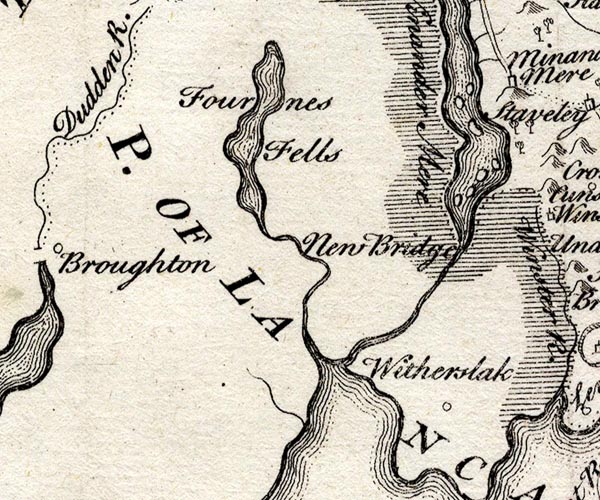
SMP2SDJ.jpg
Island in Windermere.
item:- Dove Cottage : 2007.38.59
Image © see bottom of page
placename:- Great Island
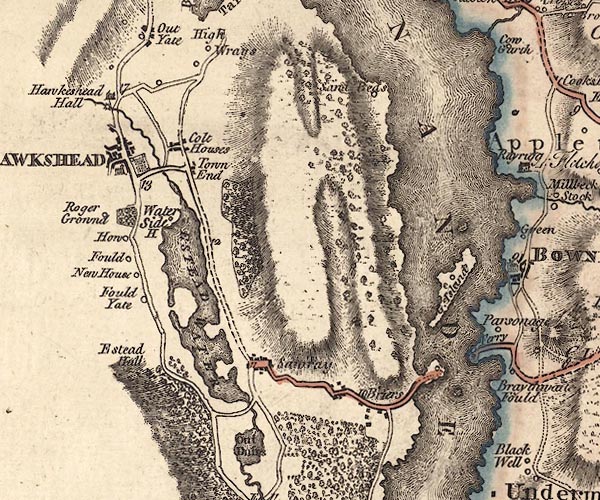
J5SD39NE.jpg
"G. Island"
island
item:- National Library of Scotland : EME.s.47
Image © National Library of Scotland
placename:- Holme Island
placename:- Great Island
 goto source
goto sourcePage 58:- "[Windermere] ... spotted with islands. Amongst them, the Holme, or Great Island, an oblong tract of thirty acres, traverses the lake in an oblique line, surrounded by a number of inferior isles, finely formed and dressed in wood. ..."
"..."
 goto source
goto sourcePage 60:- "... [from Harrow Farm] The island, from this stand, appears with much variety of shore; indented and embayed; almost surrounded with islets; adorned with ancient oaks and scattered trees [1]. ... A sweeter picture than this, the lake does not [furnish]"
"[1] In the collection of Views of the Lakes, engraved by Messrs. Byrne &c. Mr. Farrington's view from the hill above the ferry-house, represents this scene."
"..."
 goto source
goto sourcePage 61:- "... Great Island, ..."
"The island was long the property of the Philipsons, once a family of consequence in these parts [1]."
"[1] This island is now the property of Mr. Curwen, who finished the large mansion-house begun by Mr. English, laid the whole out in pleasure-grounds, in the modern style, suitable to the place, and made it one of the sweetest places that can be imagined."
placename:- Windermere Island House

CT09Vgn2.jpg
"Windermere Island House. / John Christian Curwen Esqr."
item:- Armitt Library : 2008.14.102
Image © see bottom of page
placename:- Bella Island
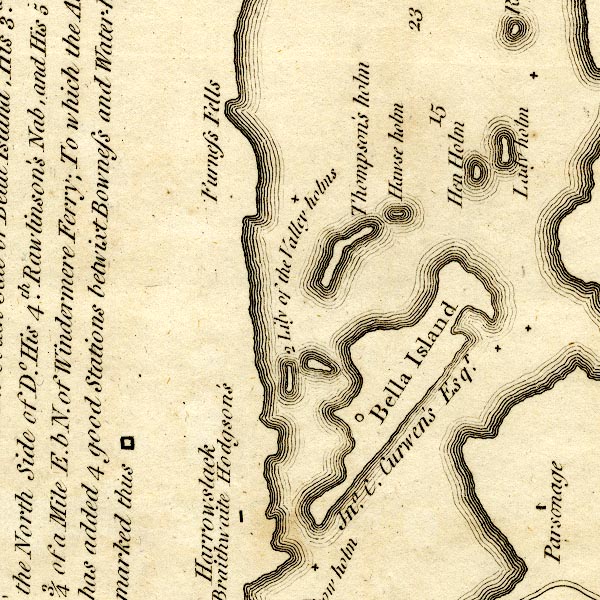
CT9SD39Y.jpg
"Bella Island / Jno. C. Curwen's Esqr."
text panel:- "..., His [Thomas West's] 2d. Station is the South Side of Bella Island. His 3d. the North Side of do. ... ..."
item:- Armitt Library : 2008.14.102
Image © see bottom of page

Ws02SD39.jpg
In Windermere Water.
item:- Armitt Library : A1221.1
Image © see bottom of page
placename:- Belle Isle ???
 click to enlarge
click to enlargeMM0101.jpg
"Painted by G. Barrett R.A. / Engrav'd by S. Middiman. / WINNANDERMERE LAKE. / Publish'd as the Act directs, Jany. 1. 1784, by S. Middiman, London."
Accompanying text:- "PLATE I."
"WINANDERMERE - LAKE,"
"WESTMORELAND."
"... The great Island, seen in the Center of this View, traverses the Lake in an oblique Direction. The sweet secreted Cottage, once embosomed in a Sycamore Grove, is now fled; the present Owner* has erected a mansion on the Bosom of the Island, which may add an Elegance to the rural Scenes that environ it; yet, by a rigid Conception of the true Sublime, it perhaps may not form a natural Contrast to the romantic Aspect of the surrounding Scenery. This Island was, for a Series of Years, the Property of the Philipsons, once a Family of Eminence in these Parts; and Sir Christopher Philipson resided upon it in the beginning of this century."
"..."
"* Mr. Christian, who has raised a Structure on the Site where Mr. English's House and Garden's stood, a few Years since."
item:- Armitt Library : A6858.1
Image © see bottom of page
item:- boat; fish; charcoal
 goto source
goto sourcevol.1 p.135 "... we embarked [from Bowness], and standing out to sea; made for the great island; which we were informed was a very interesting scene."
"We soon arrived at it; and landing at the south end, we ordered our boat to meet us at the north point; meaning to traverse it's little boundaries."
"A more sequestered spot cannot easily be conceived. Nothing can be more excluded from the noise, and interruption of life; or abound with a greater variety of those circumstances, which make retirement pleasing."
"The whole island contains about thirty acres. Its form is oblong; its shores irregular; retiring into bays, and broken into creeks."
 goto source
goto sourcevol.1 p.136 "The surface too is uneven; and a sort of little Appenine ridge runs through the middle of it; falling down, in all shapes into the water.- Like it's great mother-island, the southern part wears a smoother aspect, than the northern, which is broken, and rocky."
"Formerly the whole island was one entire grove. At present, it is rather bare of wood; though there are some large oaks upon it."
"One of it's greatest beauties arises from that irregular little Appenine, just mentioned, which extends from one end to the other. This circumstance hides it's insularity, by connecting it with the continent. In every part, except on the high grounds, you stand in an amphitheatre composed of the noblest objects; and the lake performing the office of a sunk fence, the grandeur of each part of the continent is called in, by turns, to aid the insignificance of the island."
"The oblong form also of the lake gives the island another great advantage. On both it's sides, the opposite shore of the continent is little more than half a mile distant: but at the northern and southern points there is a large sheet of water. The views therefore, as you walk round, are continually changing"
 goto source
goto sourcevol.1 p.137 "through all the varieties of distance; which are still farther improved by a little degree of obliquity, in the position of the island."
"He who should take upon him to ornament such a scene as this, would have only to conduct his walk and plantations, so as to take advantage of the grand parts of the continent around him;- to hide what is offensive - and, amidst a choice of great and picturesque scenes, to avoid shewing too much. As he would have, at all times, an exuberance of water, he should not be ostentatious in displaying it. It would be a relief to the eye sometimes to exclude it wholly; and to introduce a more sylvan scene, with distant mountains rising above it. A transient glance of the water, with some well-chosen objects beyond it, would often also have a good effect; and sometimes a grand expansion of the whole.- Thus the objects around, tho unmanageable in themselves, might be brought under command by the assistance of an insular situation."
"With regard to the ornamenting of such a scene, an elegant neatness is all the improver"
 goto source
goto sourcevol.1 p.138 "should aim at. Amidst these grand objects of nature, it would be absurd to catch the eye with the affected decorations of art. The simple idea he would desire to preserve, is, what the place itself suggests, a sequestered retreat. The boundaries should in a great measure be thicket - on the eastern coast especially, which is opposed to the only cultivated part of the country: and if there be any thing in that part worth giving to the eye, it might be given through some unaffected opening."
"For thickets, the wild wood of the country would abundantly suffice. It grows luxuriantly, and would soon produce it's effect."
"The middle parts of the island, with a few clumps properly disposed, might be neat pasturage, with flocks, and herds; which would contrast agreeably with the rough scenery around."
"The house, at present, stands too formally in the middle of the island. It might stand better near the southern promontory. The air of this sweet retreat is said to be very pure. *"
"[*] Since this view of Windermere island was taken, it hath been under the hands of improvement. The proprietor, I have been told, spent six thousand pounds upon it; with which sum he contrived to do almost every thing, that one should wish had been left undone. It is now in other hands, which may probably restore it's beauty."
item:- garden; development; fir; sycamore; picturesque
 goto source
goto sourcePage 138:- "..."
"... a part of the Lake resembling the Archipelago, to the great island, and there land. This island belongs to John Christian, Esq; member of parliament for the city of Carlisle, who had it with his wife, a miss Curwen of Workington-Hall ..."
"... Mrs Christian ... purchased the island of Mr English, who had bought it of a Mr Barlow, and laid out a considerable sum of money on the house and gardens. These, however, Mr Hutchinson found great fault with in his Guide to the Lakes, published in 1770. I shall give his own words, and let the reader judge himself:- "The few natural beauties of this island are wounded and distorted by some ugly rows of firs set in right lines, and by the works now carrying on by Mr English the proprietor; who is laying out gardens on a square plan, building fruit-walls, and planning to erect a mansion-house there. The want of taste is a misfortune too often attending the opulent, (a pretty compliment paid to the opulent!) The romantic seite of this place, on so noble a lake, and surrounded with such scenes, asked for the plan of an edifice and pleasure grounds: But instead of that, to see a Dutch burgomaster's palace arise on this place; to see a cabbage-garth extend its bosom to the East, squared and cut out at right angles, is so offensive to the eye of the traveller, that he turns away with disgust. For pleasure, or for ornament, a narrow footpath is cut round the margin of the island, and laid with white sand; resembling the dusty paths of foot passengers over Stepney fields, or the way along which the owner often has heyed to Hackney.""
"Mr West says, "Of this sequestered spot Mr Young speaks in rapture; and Mr Pennant has done it much honour by his description: But, alas! it is no more to be seen in that beautiful unaffected state in which those gentlemen saw it. The sweet secreted"
"The whole of this outcry against regularity seems to me to have arisen from that cant style of painting which Gilpin and some others have introduced into writing.Not a tree, a shrub, or an old wall, but these gentlemen take measure of by the painter's scale: A poor harmless cow can hardly go to drink, but they find fault with a want of grace in her attitude; or an horse drive away the flies with his tail, but these critics immediately find fault with the too-great quickness of his motions. Whoever examines those "abortive nothings," which Mr Gilpin calls Landscapes, will hardly be able to trace one view, how well soever he may by acquainted with it: for my own part, they put me in mind of nothing so much a those landscapes and figures which boys fancy they see in the sky at sun-set, or in the fire on a frosty evening."
"With all that can be said against regular buildings, we must consider their advantages: convenience is surely a material one, and if we consider them in a picturesque light, I cannot help thinking that an elegant mansion, just peeping through the surrounding trees, is as beautiful an object as any in a landscape. Besides, beauty is of many kinds, and one of them consists expressly in regularity; for though a street of houses, every one of which resembles another, is no very striking scene; yet houses, some old, some new, some lofty, and some low, all standing together, give us an idea of nothing but the most unpleasing confusion. Mr English might wish for both pleasure and kitchen-gardens on this hermitage, whither he meant, when he first purchased it, to retire from the bustling croud of the metropolis. Was he to take boat and sail for a walk in his garden when he had ten minutes to spare? Was he, when he wanted to read a few pages in his garden, to travel two miles to do it? Was his cook to fetch every handful of parsley, or other things of that kind, cross the Lake, perhaps in a high wind? I have with pleasure fed upon delicious fruit pulled upon that island, the very spot where two years before grew nothing but briers and thorns."
"It is naturally a bad soil, being little else than sand; except a small spot in the middle, which is an entire peat moss, and used to have gale growing upon it. I was at my last visit so very much disgusted, (to use Mr Hutchinson's words) at not finding the fruit trees here, that I heartily wish his pen, (which had been the sole reason of their being destroyed) in the fire."
"Had Mr Smith or any other painter who visited this place before Mr English's improvements, seen it afterwards, he would have found these alterations no detriment to the landscape: the bird's eye-view was certainly much improved by the variety thus introduced, as any one might at once perceive who viewed it from the eminence behind, or South-East of Bowness. Here the garden and house full in front of the view made an agreeable contrast to the woody and uncultivated scenes, where were every where else displayed. All the other islands, and the whole shore on both sides, are covered with wood, (Harrow Slack alone excepted,) which is partly hidden by the great island. Can there be any impropriety in varying this uniformity with one single spot of cultivation? Surely not: beauty is of too general a nature to be always confined within rules. Give me leave to borrow a description of this delightful place: "If one could conjure a city upon it, I should persuade myself (however it might vary the character or deviate from certain limited and rigid conceptions of rural elegance,)"
 goto source
goto sourcePage 140:- ""that, beautiful as the prospects of this Lake certainly are, there is no eye but would dwell upon them with more pleasure than it possibly can at present." From that station, how beautiful would this place have looked, where the boats seem to be plying on every side to gain the el dorado; but the gardens are no more. Mr Christian, the present owner, hath made many alterations, which I shall neither applaud nor condemn, as no one can be judge of half done work. I like his marginal bank exceeding well, but what his designs are I cannot tell: he has an ample fortune to put the best designs in execution, and I believe him a gentleman of taste. This island, which contains above thirty acres, belonged to the Philipsons of Cawgarth; but in the time of Edward the III. was common, and belonged to the barony of Kendale: amongst the escheats at that time, viz. Edward the III. according to Burn, there was "an order, that the wood in the island of Winandermere called Brendwood, (that is, fire-wood, from the Saxon word Brenne, to burn,) shall not be several, but common to all the free tenants of Kirkby in Kendale, and of Strickland, Crosthwaite, Crooke, and others, as well to depasture their cattle, as to take house-boot and hey-boot at their will, without the view of the forester." ..."
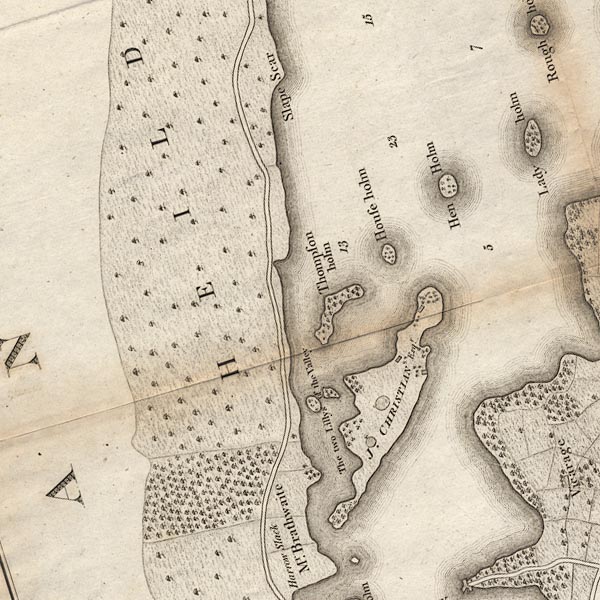
CLASD39Y.jpg
"J. CHRISTIAN Esqr."
Various buildings, and perhaps a boat house, are shown.
item:- private collection : 10.10
Image © see bottom of page
 goto source
goto sourcePage 144:- "... The holm or island in it [Windermere lake] reckoned to Westmorland contains above 30 acres, and has a good house on it, where sir Christopher Philipson lived 1705 secreted from creditors. Mr. English began a house there which was finished by Miss Curwen, since married to John Christian, esq. ..."
placename:- Long Holme
placename:- Wynandermere Island
item:- echoes; firewood; Holme House
 goto source
goto sourcePage 154:- "..."
"In this lake are several islands; the largest of which is now called Long-holme, but antiently it was called Wynandermere island."
"Among the escheats in 21 Edward III. there is an order, that the wood in the island of Wynandermere called Brendwood (that is fire-wood, from the Saxon brennan, to burn), shall not be several but common to all the free tenants of Kirkby in Kendale, and of Strikland, Crosthwaite, Croke, and others, as well to depasture with all their cattle, as to take house-bote and key-bote at their will without the view of the foresters."
"Unto whom this island was first granted in fee by the crown we have not found. It belonged in after-times to the Philipsons of Crooke; and was sold by Frances daughter and sole heir of sir Christopher Philipson, son of Huddleston Philipson, to Mr. Thomas Brathwaite of Crooke, who sold the same to one Mr. Floyer, who sold to Mr. Thomas Barlow, whose brother and heir Mr. Robert Barlow sold the same to Thomas English, esq."
"This island contains about 30 acres of ground, most of it arable; and had an handsome neat house in the middle of it called the Holme-house; which in the civil wars was besieged by colonel Briggs for eight or ten days, until, the seige of Carlisle being raised, Mr. Huddleston Philipson of Crooke, to whom it belonged, hastened from Carlisle, and relieved his brother Robert in Holme-house. The next day being Sunday Mr. Robert Philipson, with three or four more, rode to Kendal to take revenge of some of the adverse party there, passed the watch, and rode into the church up one aile and down another, in expectation to find one particular person there whom they were very desirous to have met with. Our author, Mr. Machel, who was a royalist, out of delicacy, did not chuse to name him as he was then living, but probably it was colonel Briggs. But, not finding him, Robert was unhorsed by the guards in his return, and his girths broken; but his companions relieved him by a desperate charge; and, clapping his saddle on without any girth, he vaulted into the saddle, killed a centinel, and galloped away, and returned to the island by two of the clock. Upon the occasion of this and other like adventures he obtained the appellation of Robin the devil. He was killed at last in the Irish wars at the battle of Washford."
"Upon this island there is a remarkable echo; and, for hearing the same in perfection, Mr. Barlow provided two small cannon; on the explosion whereof towards the rock on the west side of the water, there is first a burst of the sound upon the rock, exactly similar to the first explosion by lightning, then, after an intermission of about three seconds, a sudden rattling of thunder to the left. And after another intermission, when one imagines all to be over, a sudden rumbling to the right, which passes along the rock, and dies away not distinguishable from distant thunder."
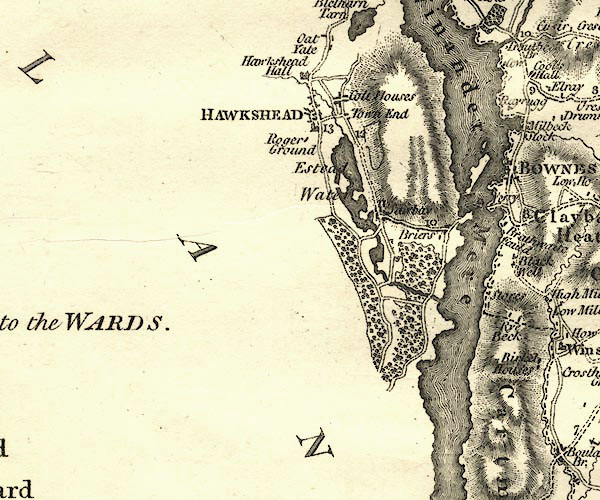
CY24SD39.jpg
island in Windermere
item:- JandMN : 129
Image © see bottom of page
placename:- Great Island
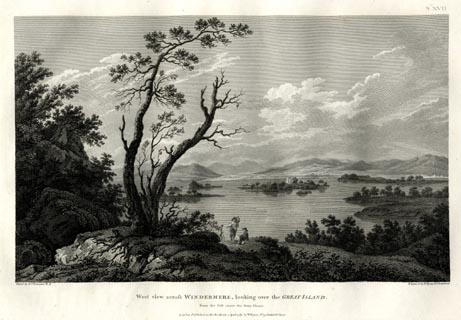 click to enlarge
click to enlargeFA0117.jpg
printed, bottom, left, right and centre "Drawn by Josh. Farington, R.A. / Engraved by W. Byrne &J. Landseer. / West view across WINDERMERE, looking over the GREAT ISLAND. / From the Hill above Ferry House. / London: Published as the Act directs, 1 April 1789, by W. Byrne, No.79, Titchfield Street."
Descriptive text, probably by William Cookson
VIEW across WINDERMERE, looking over the GREAT ISLAND.
... The Islands on Windermere (if they may be so called, many of them being rather wooded Rocks), are ten in number, composing a Kind of Archipelago, and in some Views appearing to separate the upper from the lower Reach of the Lake. In this View, which was taken on the Western Side, nearly opposite the Village of Bowness, the Great-Island, which contains about thirty Acres, forms a principal Object. It is of an oblong Shape, traversing the Lake in an oblique Line, and is the only one on which a Building is erected. From the Ferry-House beneath to Bowness, is the great Pass of Communication from the Western to the Eastern Shore.
item:- Armitt Library : A6669.17
Image © see bottom of page
placename:- Belleisle
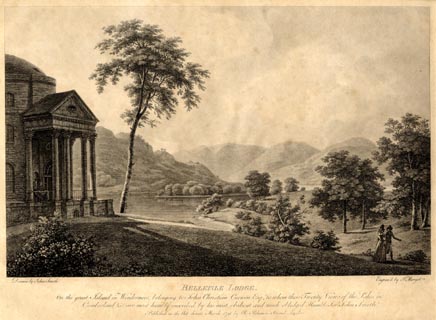 click to enlarge
click to enlargePR1850.jpg
printed, bottom left, right, centre "Drawn by John Smith. / Engrav'd by F. Merigot. / BELLEISLE LODGE. / On the great Island in Windermere, belonging to John Christian Curwen, Esqr. to whom these Twenty Views of the Lakes in / Cumberland &c. are most humbly inscribed, by his most obedient and much obliged Humble Sert. John Smith. / Published as the Act directs, March, 1791, by R. Blamire, Strand, London."
item:- Armitt Library : 2011.65
Image © see bottom of page
placename:- Belle Isle
 goto source
goto source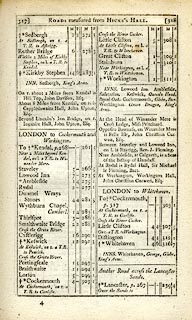 click to enlarge
click to enlargeC38317.jpg
page 317-318 "Opposite Bowness, on Winander Mere is Belle Isle, John Christian Curwen, Esq."
item:- JandMN : 228.1
Image © see bottom of page
placename:- Curwins Island
 click to enlarge
click to enlargeHM02Win.jpg
"Curwins Island"
item:- Dove Cottage : 2007.38.97
Image © see bottom of page
 goto source
goto sourceGentleman's Magazine 1805 p.1010 "[Windermere by boat] ... From the poetical rhapsodies of the guides, in delineating the charms of these islands, the imagination revels in fairy bowers and Rosicrusian Sylphs. But, instead of these, what Mr. Gray would have expressly termed a Rus in Urbeish house, and a neglected garden, served rather to excite pity than to aggravate disappointment. ..."
placename:- Great Island
 goto source
goto source"... Opposite to this place [Bowness-on-Windermere] is situated the Great Island, so called by way of pre-eminence, being the largest island in the lake, containing upwards of thirty acres, on which has been erected an elegant circular building, commanding a most beautiful prospect: the lake is about thirteen miles long. ..."
placename:-
item:- Holmes House
 goto source
goto source"[Windermere] ... There are several little islands in the lake, in the largest of which stood an old fabric, called Holmes house, now pulled down, and a curious edifice has been rebuilt in its place. ..."
placename:- Curwen Island
 goto source
goto sourcepage 16:- "Station commands an extensive and enchanting view of Windermere, and Curwen Island is the grand leading feature to which the eye is involuntarily led. The house which has been built upon it, notwithstanding what some have said, will, in many unaffected people, appear well calculated as an ornament to the scene, and a suitable place of residence for the enjoyment of the local beauties of the island, the lake, and the surrounding scenery."
"..."
 goto source
goto sourcepage 18:- "..."
"There is a walk round the Great Island, which, much to the credit of Mr. Curwen, is free to the public; the pictures are numerous from this walk, and they are fine, especially when combined with wood, of which there is a profusion."
"Some picturesque old oaks on the northern end of the island, give value to the Rydal, Ambleside, and Troutbeck distances, rendering them additionally aerial by the boldness of the contrast."
"..."
item:- larch trees; holly trees; ash trees; plantations
 goto source
goto sourcepage 63 "... It will be sufficient here to utter a regret for the changes that have been made upon the principal Island at Winandermere, and in its neighbourhood. What could be more unfortunate than the taste that suggested the paring of the shores, and surrounding with an embankment this spot of ground, the natural shape of which was so beautiful! An artificial appearance has thus been given to the whole, while infinite varieties of minute beauty have been destroyed. Could not the margin of this noble island be"
Wordsworth 1810
 goto source
goto sourcepage 64 "given back to nature? Winds and waves work with a careless and graceful hand: and, should they in some places carry away a portion of the soil, the trifling loss would be amply compensated by the additional spirit, dignity, and loveliness, which these agents and the other powers of nature would soon communicate to what was left behind. As to the larch-plantations upon the main shore, - they who remember the original appearance of the rocky steeps, scattered over with native hollies and ash-trees, will be prepared to agree with what I shall have to say hereafter upon plantations in general."
placename:- Curwens Island
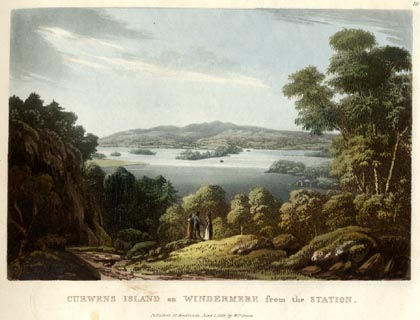 click to enlarge
click to enlargeGN0509.jpg
Plate 10 in Lake Scenery.
printed at upper right:- "10"
printed at bottom:- "CURWENS ISLAND on WINDERMERE from the STATION. / Published at Ambleside, June 1, 1815, by Wm. Green."
item:- Armitt Library : A6646.9
Image © see bottom of page

OT02SD39.jpg
item:- JandMN : 48.1
Image © see bottom of page
placename:- Belle Isle
 goto source
goto sourcePage 3:- "... The numerous islands, with which it [Windermere] is enriched, are chiefly grouped near the middle of the lake; so as to admit greater scope for the exercise of sailing. The principal, called Belle-Isle - from the late Mrs. Curwen who purchased it into the family - is a beautiful plot of thirty acres, surmounted by a stately mansion, and encircled by a gravel walk of nearly two miles, which strangers are freely permitted to perambulate. ..."
item:- Civil War
 goto source
goto sourceGentleman's Magazine 1825 part 1 p.414
From the Compendium of County History:- "1645. In this year, probably, Colonel Briggs besieged Holme House, Winandermere, eight or ten days, until the raising of the seige of Carlisle brought Mr. H. Philipson of Crooke, to whom it belonged, to the relief of his brother Robert in Holme House. ..."
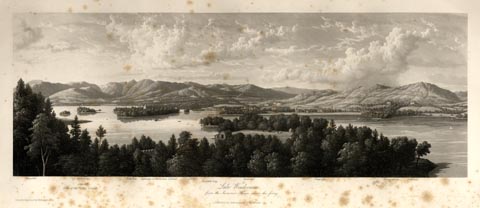 click to enlarge
click to enlargeWTL305.jpg
"Wansfell. Lilly of the Valley Islands. Kirkstone. Calgarth. Hill Bell. Curwen's, or Berkshire Island. Ellery. Bowness-bay. Bowness. Vicarage. Ferry. Ferney Green. Bellfield. / Lake Windermere, / from the Summer House above the ferry. / Drawn & Engraved by W. Westall A.R.A. / Published by Ackermann & Co, 96 Strand."
item:- Armitt Library : A6658.5
Image © see bottom of page
placename:- Monarch Isle
 goto source
goto sourcePage 23:- "... Down the lake, the eye rests upon the Monarch Isle, lying amid its dependents - the Ferry House and Station on the west - Bowness on the east, ..."
placename:- Curwen's Island
placename:- Belle Isle
 goto source
goto sourcePage 26:- "..."
"Of the numerous islands that crowd the narrow part of the Mere [Windermere], we shall only mention two: ... and Curwen's Island, or Belle Isle, a very sequestered spot, belonging to H. C. Curwen, Esq. of Workington Hall. It contains about thirty-six acres, is nearly two miles in circumference, and there is a gravel walk round its margin, on which strangers are allowed to walk. Its figure is oblong, the shores irregular, with tiny creeks and retiring bays, in which the weeping willow droops its elegant branches. Great variety of forest trees and other wood adorn the island - the massy Scotch fir, the noble chestnut, and the embowering plane, with ancient thorns aud (sic) yews. The house is of a circular form, and was built by Mr. English, a former proprietor of the island. ..."
placename:- Curwen's Island
placename:- Belle Isle
 goto source
goto sourcePage 23:- "... Down the lake, the eye rests upon the Monarch Isle, lying amid its dependents - the Ferry House and Station on the west - Bowness on the east, ..."
 goto source
goto sourcePage 26:- "..."
"Of the numerous islands that crowd the narrow part of the Mere [Windermere], we shall only mention two: ... and Curwen's Island, or Belle Isle, a very sequestered spot, belonging to H. C. Curwen, Esq. of Workington Hall. It contains about thirty-six acres, is nearly two miles in circumference, and there is a gravel walk round its margin, on which strangers are allowed to walk. Its figure is oblong, the shores irregular, with tiny creeks and retiring bays, in which the weeping willow droops its elegant branches. Great variety of forest trees and other wood adorn the island - the massy Scotch fir, the noble chestnut, and the embowering plane, with ancient thorns aud (sic) yews. The house is of a circular form, and was built by Mr. English, a former proprietor of the island. ..."
 click to enlarge
click to enlargeAS0402.jpg
"from Mitchel Knot / Oct 2. 1863"
page number "2"
item:- Armitt Library : 2008.60.2
Image © see bottom of page
 click to enlarge
click to enlargeAS0170.jpg
"Octr. 6th. 1849. / Ferry nab & Curwens Isd."
item:- Armitt Library : 1958.487.70
Image © see bottom of page
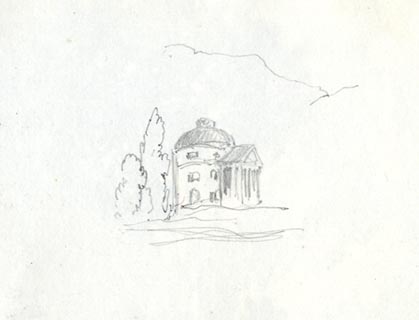 click to enlarge
click to enlargeAS0171.jpg
item:- Armitt Library : 1958.487.71
Image © see bottom of page
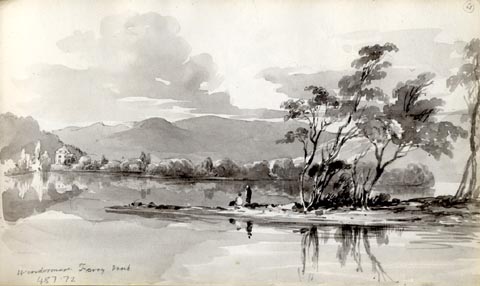 click to enlarge
click to enlargeAS0172.jpg
"Windermere Ferry Nab"
item:- Armitt Library : 1958.487.72
Image © see bottom of page
 goto source
goto sourceGentleman's Magazine 1849 part 2 p.255 "..."
"In 1705 Sir Christopher Philipson, the last male-heir of the family of Crooke Hall, died, leaving a daughter and heiress named Frances (according to Dr. Burn, in page 155 of his History of Westmerland, though, in page 141, he mentions Elizabeth and Clara, two other daughters, as selling their joint estate to Major Pigeon, a natural son of Charles II.), who, in 1714, sold the heritage of her ancestors to various purchasers, and disposed of the island to a Mr. Braithwaite. After its possession by several subsequent owners, it was, in 1775, sold to a progenitor of the present inheritor, who changed its ancient name to that of Christian's Isle, afterwards altered to Belle Isle by which it is now known. Subsequently the ground, which, from a"
 goto source
goto sourceGentleman's Magazine 1849 part 2 p.256 "description left by a writer in the Gentleman's Magazine for 1748, appeared "one of the loveliest and most sacred seats of simplicity, almost covered with noble trees, amidst which was the ancient mansion of the Philipsons," was, from the designs of a celebrated landscape gardener, laid out in its present style of park-like elegance; and the old fortified house of its early lords was made to give way to an edifice whose classic appearance has occasioned its being, with more harmony of versification than architectural descrimination, poetically noticed as -"
"A Grecian temple rising from the deep,"
"erected from the designs of the late eminent architect, Sir William Chambers. On sinking the foundations of this handsome building, many pieces of armour, weapons, and cannon-balls, indubitable memorials of the days of its hero Robin, were found embedded in the soil; and other curiosities, reminiscences of that more distant aera when Roman domination governed England, testifying the former existence on this insular paradise of a structure of that powerful people, were likewise disinterred from their long repose of ages."
"Like most of the other neighbouring families of ancient lineage and local prominence, the Philipsons are gone also. Their race has died out, and been forgotten in the very place which they once occupied with all the authority of feudal lords. Their mouldered dust lies beneath the pavement in Windermere church, and their homes, for the most part but grey and naked ruins, know them no more. Perishing, however, as these fabrics are, thay have outlived the power of their early possessors; and, though mute and motionless in their desolation, they yet stand to proclaim the instability of all earthly greatness. Now, save this shattered remnant of their antique hall, the monument which covers their last resting-place beside the altar in the neighbouring church, some scanty records of their genealogy gathered by the local historians, the literary relics in Cartmel church, and the vanishing traditions floating about the vicinage or preserved in a contemporary ballad - all vestiges have disappeared of a family who for ages exercised an important influence over the surrounding country."
"H.C.M."
 goto source
goto sourceGentleman's Magazine 1849 part 2 p.251 "..."
"The Philipsons were lords also of the large island in the centre of the lake, opposite to Bowness; which, with its stately trees and splendid prospects, entrancing the eye with their exquisite loveliness, is such an earthly paradise. No fairer scene in truth can be met with throughout the broad realm of England than this lovely and elegant retirement. In looking on it one feels it scarcely possible to suppose that the aspect of so much bright tranquillity could ever have been disturbed by the clangor of war and sounds of deadly"
item:- Civil War
 goto source
goto sourceGentleman's Magazine 1849 part 2 p.252 "strife - but so nevertheless it was; and the island is not more attractive by its beauty than for the memory of one of the most gallant actions performed by the Royalists in the troublous epoch of the civil war. The olden name of this sweet spot was Wynandermere Isle, afterwards changed to Lang Holme; the latter word signifying in the provincial dialect an island or plain by the waterside. In the middle the Philipsons had a plain country house of the old fashioned Westmerland kind, strongly secured and fortified, called Holme House; and , like the gallant Wyndhams of Somersetshire, whose uncompromising principle of loyalty it was "to stand by the Crown, though it should hang on but a bush," the owners of the island were not more distinguished for their steady support of the King than for the resolute bravery and romantic spirit of heroism with which they fought and suffered in the royal cause. With them, as with a poet of the period -"
"Loyalty was still the same,
Whether it win or lose the game;
True as the dial to the sun,
Altho' it be not shone upon."
"..."
placename:- Belle Isle

GAR2SD39.jpg
"Belle Isle"
island
item:- JandMN : 82.1
Image © see bottom of page
placename:- Belle Isle
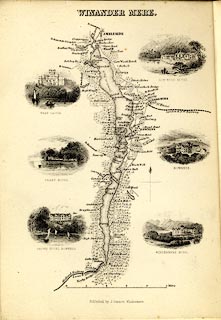 click to enlarge
click to enlargePI03M1.jpg
"Belle Isle"
island
item:- private collection : 133.1
Image © see bottom of page
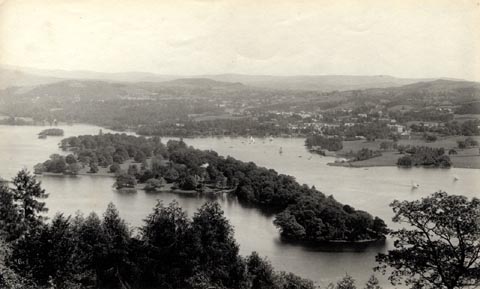 click to enlarge
click to enlargeHB0805.jpg
internegative at lower left:- "H. Bell"
item:- Armitt Library : ALPS468
Image © see bottom of page
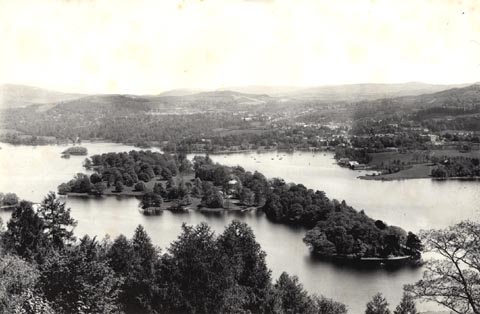 click to enlarge
click to enlargeHB0265.jpg
item:- Armitt Library : ALPS619
Image © see bottom of page
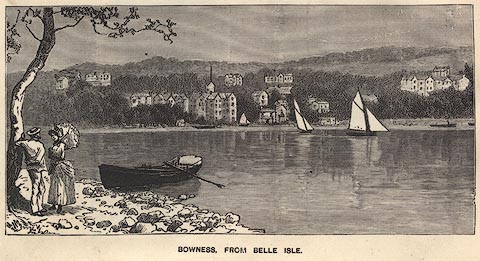 click to enlarge
click to enlargePW1E01.jpg
"BOWNESS, FROM BELLE ISLE."
item:- JandMN : 58.2
Image © see bottom of page
 click to enlarge
click to enlargePCH102.jpg
printed, "Bowness From Furness Fell. / ..."
item:- JandMN : 1015.2
Image © see bottom of page
placename:- Belle Isle
courtesy of English Heritage
"BELLE ISLE / / / WINDERMERE TOWN / SOUTH LAKELAND / CUMBRIA / I / 351655 / SD3928496478"
courtesy of English Heritage
"Built 1774, designed by John Plaw, it was the first house in the Lake District to be built for picturesque reasons. Unique in having a circular plan. Crowned by a dome with a lantern. Ionic entrance portico of 4 unfluted columns, and Venetian windows in the other cardinal sides. The basement is square, with 3 storeys and attics above in a cylinder. The island was landscaped by Thomas White in the 1780's. See Country Life article."
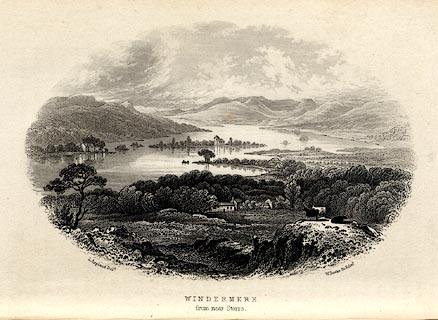 click to enlarge
click to enlargeMNU103.jpg
Opposite p.13 in A Complete Guide to the English Lakes, by Harriet Martineau.
printed at bottom left, right, centre:- "L Aspland Delt. / W Banks Sc Edinr. / WINDERMERE / from near Storrs."
item:- Armitt Library : A1159.3
Image © see bottom of page
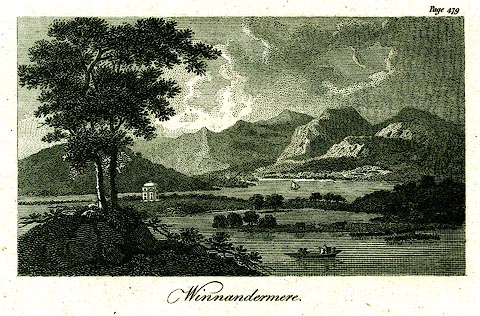 click to enlarge
click to enlargePR0289.jpg
printed at bottom:- "Winandermere"
item:- Dove Cottage : 2008.107.289
Image © see bottom of page
placename:- Curwen Island
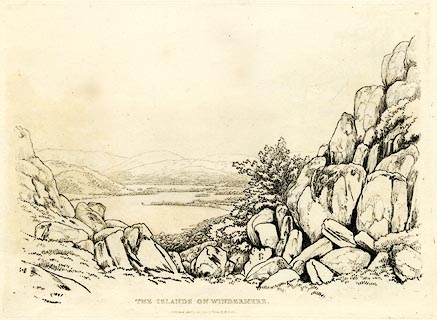 click to enlarge
click to enlargeGN0349.jpg
Plate 49 in Seventy Eight Studies from Nature.
printed in introductory pages to set of prints:- "Number 49. Curwen Island, the property of John Christian Curwen, Esq. and the largest Island on Windermere, apparently uniting with the promontories, seems to cut the lake in two; ... This view is from the Fellside, above Beech Hill."
printed at bottom:- "THE ISLANDS OF WINDERMERE. / Published Ambleside, Augst. 1st. 1809, by W. Green."
item:- Armitt Library : A6637.49
Image © see bottom of page
placename:- Great Island
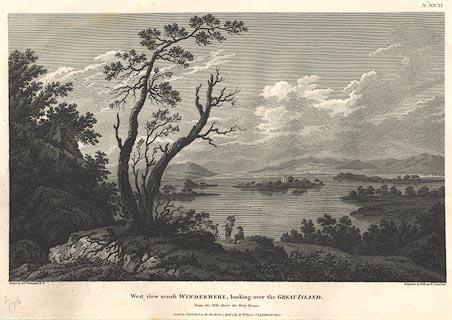 click to enlarge
click to enlargeBMZ11.jpg
The lake with a fine background of mountains, Belle Isle clear; a group of travellers in the foreground.
Plate 17 from Views of the Lakes, &c, in Cumberland and Westmorland, published 1789; with descriptive text:- "VIEW across WINDERMERE, looking over the GREAT ISLAND."
"... The Islands on Windermere (if they may be so called, many of them being rather wooded Rocks), are ten in number, composing a Kind of Archipelago, and in some Views appearing to separate the upper from the lower Reach of the Lake. In this View, which was taken on the Western Side, nearly opposite the Village of Bowness, the Great-Island, which contains about thirty Acres, forms a principal Object. It is of an oblong Shape, traversing the Lake in an oblique Line, and is the only one on which a Building is erected. ..."
item:- Dove Cottage : Lowther.12
Image © see bottom of page
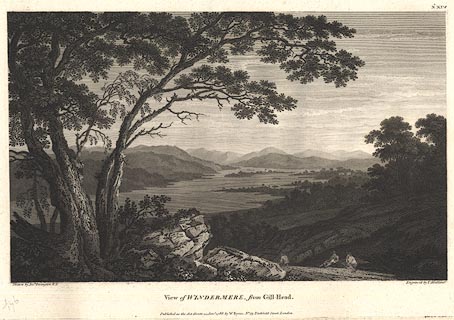 click to enlarge
click to enlargeBMZ10.jpg
View down the lake, Belle Isle clear in the distance. Plate 14 from Views of the Lakes, &c, in Cumberland and Westmorland, published 1789; with descriptive text:- "VIEW of WINDERMERE from GILL-HEAD. ... the Lake is divided into two Parts by a Cluster of Islands, one of which, being much larger than the rest is usually called the Great-Island. ..."
item:- Dove Cottage : Lowther.11
Image © see bottom of page
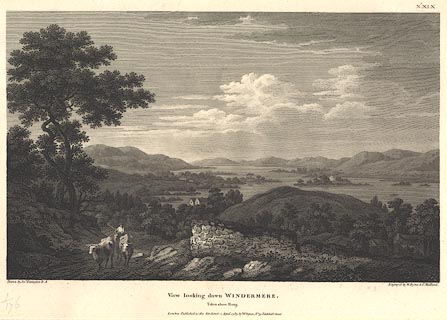 click to enlarge
click to enlargeBMZ09.jpg
A farmer on horseback drives cattle up Rayrigg Bank in the foreground, Belle Isle is clear in the lake.
Plate 19 from Views of the Lakes, &c, in Cumberland and Westmorland, published 1789; with descriptive text:- "VIEW looking down WINDERMERE from above RARIG. ..."
item:- Dove Cottage : Lowther.10
Image © see bottom of page
